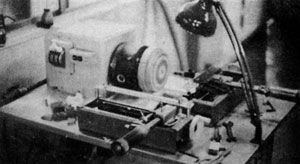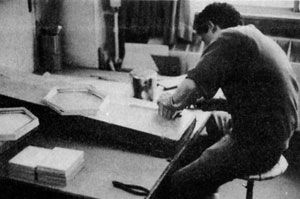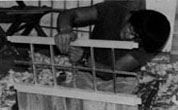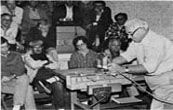|
|
The
following article was originally published in
Wood News
No.
16, Fall 1985.
Japanese
Woodworkers
by Tom
Frazer
In
Kyoto, Japan, a few supreme artisans such as woodworker Isaburo Wada
still ply their craft in a timeless tempo known as "Kyoto
time".
For more than a thousand years, Kyoto was the capital
of Japan. As such, her rulers attracted the most skilled artisans,
and slowly, over the centuries, the city became a repository of the
highest expression of artistic endeavor.
By good fortune, I
was invited to Japan last fall by that country's Ministry of Foreign
Affairs and was able to meet Wada and other Japanese woodworkers, as
well as most of the master toolmakers of Miki City.

 And
indirectly from Wada, I learned the meaning of "Kyoto time". It went
like this:
And
indirectly from Wada, I learned the meaning of "Kyoto time". It went
like this:
Wada is the sixth generation head of Enami Co., Ltd.,
a company that has specialized in textiles and traditional Kyoto
joinery for 200 years. It is the oldest Kyoto joinery firm still in
business. As he showed me through his multi-story workshop, a large,
donut-shaped piece of wood caught my eye, and I asked Wada what it
was.
"It's going to be a traditional hibachi," answered Wada.
Then glancing at his homemade lathe, he commented, "I could have
turned it on that machine in five minutes, but I wanted to shape the
wood the old-fashioned way, by hand planing. But you must shave off
only a small amount at a time. Otherwise, the wood will
crack."
"How long have you been working on it?" I asked in all
innocence.
"Ten years," responded Wada. "And the wood was aged
ten years before I began work."
Wada, official boxmaker to
the Emperor, thus knows how to work according to "Kyoto time", a
timeless time in which an artist works to utter perfection, his
attitude uncluttered by any other earthly consideration.
But
don't imagine that Wada is simply a cobwebby throwback to
yesteryear. He is a tireless experimenter, and uses everything from
outdoor weathering to chemicals and a kiln to stabilize the shape
and color of wood. Although he has achieved 20-year stabilization,
Wada nevertheless is dissatisfied and says he is trying to do even
better.


He is particularly proud of an elaborate wood lathe
he designed and constructed of aluminum, welding it himself. The
lathe is used chiefly for making wooden bowls, and because Wada
wanted to make it easier for apprentices to duplicate a given shape,
he designed his own screw-feed bit arrangement, very similar to that
of a mctalworking lathe. Instead of employing a hand-held turning
tool, an apprentice can turn handscrews to feed the cutting
bit.
But Wada's crowning achievement with his lathe is his
own novel design which permits the workpiecc to be held onto the
chuck by vacuum supplied by an electric air pump. Without screws or
chuck jaws, Wada pointed out, the wood cannot possibly be
damaged.
Without doubt, Wada's dogged pursuit of artistic
achievement resulted in his being designated a kyo-sashimono, or
traditional craft joiner, by the Japanese government in 1977. Three
years earlier, Wada made 36 boxes for the Ise Shrine, the holiest
shrine of Japan's native Shinto religion. (Showing a spirit
remarkably different from the builders of the pyramids, officials
responsible for the Ise Shrine order the sacred wooden complex torn
down and painstakingly rebuilt at 20 year intervals.)
Wada
and his ten apprentices specialize in handcrafting exquisite
small-to-medium sized objects of wood, such as intricate boxes,
bowls, screens, trays, lamps, inkstone containers, spoons, tables,
chests and shelves.
Wada and his craftsmen use some 35
varieties of hardwood and softwood, although he said about sixty
percent of what he uses is paulownia. He described it as "the
lightest and softest wood in Japan."
Years ago, Wada said,
paulownia was exported to the United States where it was planted as
a shade tree. But since no one used it for any other purpose, he
said, the Japanese are now importing it back to Japan. "It has a
cell structure similar to grass and only grows a maximum of about
eighty years, like a human being," said Wada. "When it reaches forty
to sixty years, that is the best time to take the tree - also the
best age for a craftsman to produce his best work." said
Wada.
The kyo-sashimono is so determined to preserve
traditions that his workshop still can turn out an incredible 7500
different wooden objects of traditional Kyoto design. In many cases,
the objects are made in exactly the same manner that craftsmen made
them 1000 years ago. Sometimes, over the centuries, the designs
evolved minutely. For instance, items made for the Ise Shrine
included a box-like container crafted from peeled willow switches to
hold cups and slippers. According to Wada, the original containers
were tied together with strips of willow bark. Now he uses silk
thread to copy the newer, current design.
Although Wada
employs the use of some power tools, traditional Japanese hand tools
account for the bulk of his shop's craftsmanship. His company
possesses a collection of some 45,000 hand tools, among them planes
between 200 and 400 years old.
Wada's apprentices sit at the
lower end of slanted, thick cherry planks that serve as workbenches.
Only a small wooden stop set into the plank at the apprentice's end
adorns the workbenches. Traditionally, said Wada, craftsmen sat on
cushions on the floor and bent over their work. But because bending
for long periods can hurt the back, Wada has arranged for the
workbenches to be elevated and his apprentices now sit on low
stools.


For himself, Wada reserves a small room for his
private workshop. He sits on a cushion and works under a solitary
hanging lamp. On the tatami mat within easy reach are a variety of
marking gauges, chisels, saws and planes. More saws and planes rest
in wall racks.
For an interested visitor, Wada will pluck
several ancient tools from their special places and display them
reverently. He explains that the small saw and the worn chisel were
made from very special blue steels, which enable them to hold their
sharpened cutting edges longer than the tools available today. Wada,
a traditionalist, treasures their exquisite quality.


Another premier Kyoto woodworker is Kenkichi Kuroda,
the teacher mentioned by Charles Roche, his former student who wrote
about Japanese lacquer in the March '85 issue of Fine Woodworking.
Thanks to Howard Lazzarini, another former student, I was able to
meet Kuroda, who specializes in lacquered wooden
trays.
Lazzarini, both guide and translator, explained that
Kuroda is unusual in Japan because he both crafts the trays and
applies the lacquer. Normally, he said, craftsmen concentrate on
either one or the other.
A lacquered tray measuring roughly
12 by 18 inches requires an "absolute minimum" of a month and a half
to complete, said Lazzarini, adding that prices run in the vicinity
of $500 to $600.
Incidentally, Lazzarini recalled that during
the first three months of his apprenticeship, he was restricted to
sharpening tools. "Regular" Japanese apprentices, he said, begin by
sharpening tools for six months before being allowed to move
forward. During this time, Lazzarini said, he also made his own tiny
finger planes, shaping the metal blades as well as the wooden
bodies.
Kuroda often uses an elm-like wood called zelkova
with a very pronounced grain pattern. Moreover, he clearly is a
"wood freak" equal to any of us. In one room of his house he proudly
shows off huge, thick planks of a wood that translates as "horse
chestnut". It is shot through with a highly-figured, burl-like
pattern. Looking fondly at his precious wood, he joked with a smile,
"My friends say they are anxious for me to die."
Kuroda,
according to Lazzarini, is a philosopher (or philosophizer) when it
comes to wood. "He feels that there is a proper way to use wood. And
wood from a 500- or 600-year-old tree should be used in a special
way."
Speaking for himself, Kuroda said, "In today's Japanese
society, it is important to have automated things. Japan is
concerned with fads, and right now, handicraft is 'in'". But Kuroda
warned, "That is not a good way to approach wood. It is better to
really work with your soul - not because it is a
fad."
Lazzarini recalled that during his apprenticeship,
Kuroda "told us to treat wood with reverence. He told us that good
pieces are rare." Furthermore, Kuroda rejects the idea that human
beings are somehow "above" things such as wood, Lazzarini said.
"Kuroda holds that wood also has a spirit and that people should
treat wood with the same respect that they treat other
people."
The lacquer traditionally used by Japanese
craftsmen, incidentally, doesn't come from a can. It comes as thick
brown sap from the Urushi tree, and frequently produces a rash like
that caused by poison sumac. After someone works with the sap for
some time, he generally becomes immune to it. But Kuroda said that
even after years of using lacquer, he sometimes gets a rash on soft
portions of skin, such as between his fingers and behind his
ears.
One of Kuroda's prize possessions is a lacquer brush
given to him by his late father, one of Japan's elite "Human
National Treasures". The brush is 300 years old and is made from
human hair. Kuroda confides that many Japanese lacquer craftsmen
believe the best brush hair comes from fishermen. "But some argue
for women's hair", he added. Japanese craftsmen seem to cherish such
small points.
When I told Lazzarini that I found ripping with
a Japanese-style saw awkward because of the shape of the teeth, he
responded that Kuroda takes both his saw and the wood he intends to
cut to a sharpener, and instructs him to sharpen the teeth
appropriately for that particular type of wood!
|
|







